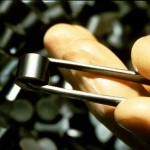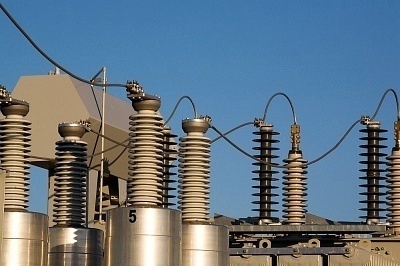The different nuclear processes will use different types of fuel. In general terms:
- Fission reactions will use fissile heavy elements
- Fusion will use fusible light elements
The convection point is iron. Elements heavier that iron will have higher mass than its parts and yield energy when they break apart. Lighter elements that iron will have less mass than its parts giving away energy when they fusion.
Very unstable substances will not be useful, they need to be stable under normal conditions but become unstable when bombarded with neutrons. Special isotopes able to generate a chain reaction are chosen as nuclear fuel.
Fission Nuclear Fuels
The known fissile materials are:
- Uranium-233
- Uranium-235
- Plutonium-238
- Plutonium-239
- Plutonium-241
- Neptunium-237
- Curium-244
 The most often used fuels are Uranium-235 and Plutonium-239; they become instable when bombarded by slow (also known as “thermal”) neutrons. They are not easy to find or produce materials, and the process to generate them is usually the most expensive part in the creation of a nuclear bomb. Uranium-233 was used in a couple of test bombs in USA and it is supposed to be the main component in India’s bombs. Thorium-232 is also fissile but it needs fast moving neutrons to start the chain reaction.
The most often used fuels are Uranium-235 and Plutonium-239; they become instable when bombarded by slow (also known as “thermal”) neutrons. They are not easy to find or produce materials, and the process to generate them is usually the most expensive part in the creation of a nuclear bomb. Uranium-233 was used in a couple of test bombs in USA and it is supposed to be the main component in India’s bombs. Thorium-232 is also fissile but it needs fast moving neutrons to start the chain reaction.
Uranium-235
General Facts
- The most often isotope of Uranium found in Nature is U-238, U-235 is only found in low proportions (0.71%).
- U-235 is created from U-238 via isotope separation.
- The critical mass for an unreflected sphere of U-235 is about 50 kg (17 cm of diameter).
Fission Process
- One slow neutron strikes a U-235 atom; the result is U-236.
- U-236 is highly unstable and it fissions. There are twenty different fission processes, the products masses always add up 236.
Example: U-235 + 1 neutron -> 2 neutrons + Kr-92 + Ba-142 + ENERGY
The Chain Reaction
For each U-235 nucleus that absorbs one neutron, two neutrons are yield. Those two neutrons are free to combine with two U-235 nuclei, giving away four neutrons. The number of nuclei fissioning grows like 2^n. The process goes on until the energy emitted breaks the enclosure and the bomb explodes. The remaining U-235 will undergo the fission process with normal decaying rate (the half-life of U-235 is 7.1 x 108 years).
Plutonium-239
General Facts
- Plutonium is very rare in nature.
- For military purposes, it is obtained processing Uranium-238 in breeder reactors.
- It has a reasonably low rate of neutron emission due to spontaneous fission.
- It is usually contaminated with Plutanium-240 which is more unstable (4%-7% of plutanium-240 is considered bomb-grade). This is the reason why plutonium-based weapons must be implosion-type, rather than gun-type.
- The critical mass for an unreflected sphere of Plutonium is 16 kg. Fission process: When Platinium-239 absorbs a slow neutron it becomes Platinium-240, which decays fast via different processes emitting at least two neutrons.
The Chain Reaction
There are around 80 generations in the chain reaction. The whole process takes 0.8 microseconds.
Uranium-233
General Facts
- U-233 is not found naturally.
- It is obtained from Thorium-232 in nuclear reactors.
- The fissile properties of U-233 are similar to U-235 and Pu-239.
Fission Process
- When U-233 absorbs a neutron, it becomes U-232.
- U-232 has the property of emitting gamma radiation (neutrons) at levels higher than weapon-grade plutonium-239.
Glossary
Fissionable: any material with atoms that can undergo nuclear fission.
Fissile: materials fissionable by slow neutrons. “Fissile” is more restrictive than “Fissionable”.
Fusion Nuclear Fuel
Fusion reactions are induced by a mixture of the hydrogen isotopes deuterium (H-2) and tritium (H-3), forming heavir helium nucleus.
The Process
H-2 + H-3 He-5 -> He-4 + 1 neutron + ENERGY
H-2 and H-3 will not undergo the fusion process in normal conditions. They need extremely high temperatures and pressures for this to happen. The reason lies on the fact that there are two main opposite forces in game, electromagnetic repulsion of the protons and nuclear attractive forces. Nuclear forces are stronger that electromagnetic forces but they have a very short range, so the nuclei need to overcome a repulsive barrier before being able to be at binding distances. This is why all fusion bomb designs use a fission devise as trigger.
Like Tritium is very difficult to confine, most bombs carry Lithium instead and use the fact that Li breeds H-3 when bombarded by a neutron:
Li-6 + n -> He-4 + H-3
The Chain Reaction
The process will be able to sustain itself if part of the produced energy goes to keep the high temperatures and pressures needed to make deuterium and tritium to react. He-4 is one of the most stable elements in nature, so the product atoms will not react by themselves under these conditions. The neutrons expelled during the process will attack more Li atoms generating the H-3 needed for the process, when Li is used as initial element.
For more information on nuclear energy, visit Nuclear Power Now.




Simon Gunson
The article mentions Thorium as being fissile whereas in reality it is fertile, meaning stable but able to be transmuted into something radioactively unstable. In the mid 1950s the Soviets did test blast some Thorium A-bombs and likely this was induced by an external plasma pinch effect, perhaps between Lithium and Tritium. The fall out was abundant in Thorium 231.
Generally speaking however Thorium is not fissionable. It can be converted to Uranium 233 via Protactinium 233, either with a reactor or a particle accelerator via a process of transmutation.